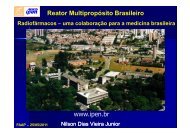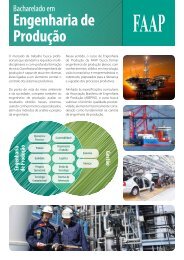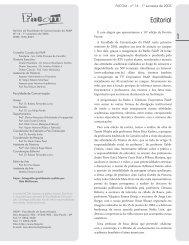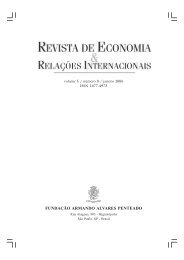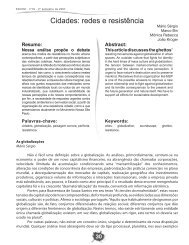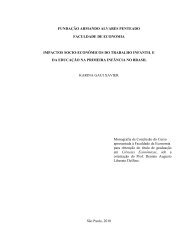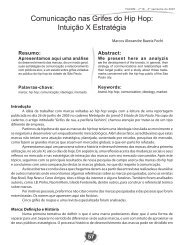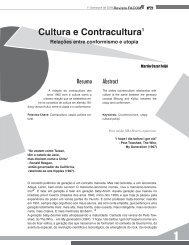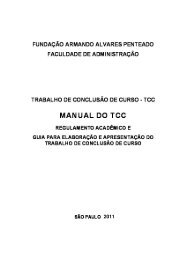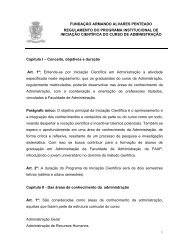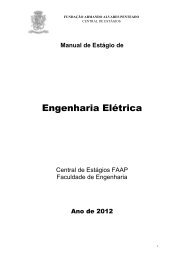Guia de Estudos - Faap
Guia de Estudos - Faap
Guia de Estudos - Faap
Create successful ePaper yourself
Turn your PDF publications into a flip-book with our unique Google optimized e-Paper software.
erra Leone and the Democratic Republic of the Congo<br />
that conflict diamonds are originated. According to The<br />
United Nations (UN) conflict diamonds are <strong>de</strong>fined as<br />
64<br />
(...) diamonds that originate from areas controlled by<br />
forces or factions opposed to legitimate and internationally<br />
recognized governments, and are used to fund military action<br />
in opposition to those governments, or in contravention<br />
of the <strong>de</strong>cisions of the Security Council.<br />
There is a speech ma<strong>de</strong> by Ambassador J.D. Bin<strong>de</strong>nagel<br />
– Former U.S Special Negotiator for Conflict<br />
Diamonds that well illustrates this theme, it says that<br />
diamonds are classified as an one of a kind resource,<br />
producing a strong feeling of eternal love and beauty.<br />
In the recent past, after rebel groups located in Africa<br />
started to use diamonds as a means of financing their<br />
ineffable inhumanity versus the civilian populations<br />
and wars many pictures of injured children have menace<br />
to oppress these traditionally positive images. The<br />
international community, due to these conflicts, was<br />
mobilized to assure the individuals that live in countries<br />
plentiful of diamonds are able to get <strong>de</strong>posits with their<br />
patrimony’s benefits.<br />
Since the beginning of the 20th century, areas rich<br />
in diamonds have endured unmeasured <strong>de</strong>vastation<br />
on account of their wealth. The term “conflict diamond”<br />
only appeared recently on public’s consciousness, as the<br />
funds used to conduct <strong>de</strong>adly civil wars in Africa were<br />
traced back to diamonds. This issue only captured the<br />
world’s eyes during the brutal conflict in Sierra Leone<br />
in the late 1990s. According to the organization World<br />
Diamond Council, during this time, it is estimated that<br />
conflict diamonds represented approximately 4% of<br />
the world’s diamond production. Illicit rough diamonds<br />
have also been used by rebels to fund conflicts in Angola,<br />
Liberia, Ivory Coast and the Democratic Republic<br />
of Congo. However, the conflict diamond tra<strong>de</strong> has<br />
left permanent scars to people and nations around the<br />
world, fueling bloody civil wars, human rights abuses<br />
and child labor. In addition to that, it has been quite impossible<br />
to verify the origin of diamonds and the conditions<br />
they are produced.<br />
One of the main issues to be tackled is the issue of<br />
rebel groups, who uses these diamonds as financing<br />
towards illicit operations in contravention of the international<br />
community’s objectives of restoring peace in<br />
the continent. These groups are accused to have com-<br />
VII Fórum FAAP <strong>de</strong> Discussão Estudantil - 2011<br />
mitted numerous atrocities, including kidnappings,<br />
mur<strong>de</strong>rs, rapes and amputations in or<strong>de</strong>r to control<br />
diamond tra<strong>de</strong>. As an example, based on UN reports,<br />
Al-Qaeda regularly used diamonds to buy weapons<br />
and tra<strong>de</strong>d opium and heroin for gold. These precious<br />
stone has been used also to make money and to hi<strong>de</strong><br />
the group finances.<br />
It is also known that the global diamond industry is<br />
<strong>de</strong>dicated to eradicating tra<strong>de</strong> in conflict diamonds, it<br />
works closely with the UN, governments and non-governmental<br />
organizations (NGOs) such as Global Witness<br />
and Partnership Africa Canada, to create the Kimberley<br />
Process Certification System. This system was formally<br />
adopted in 2003 and verses against conflict diamonds<br />
entering the legitimate diamond supply chain. The<br />
diamond industry also adopted a voluntary System of<br />
Warranties to assure consumers that their diamonds are<br />
from sources free of conflict. Nowadays, 74 governments<br />
have adopted their national law based to the Kimberley<br />
Process, and now more than 99% of the world’s diamonds<br />
are from conflict free sources. Although the fact<br />
remains the same, in other words, conflict diamonds still<br />
exists; because the problem is not the diamonds themselves<br />
but the rebels who exploit these diamonds in or<strong>de</strong>r<br />
to achieve illicit goals.<br />
At this point, it is important that non-governmental<br />
and inter-governmental organizations and Governments,<br />
arms manufacturers, financial institutions, diamond<br />
tra<strong>de</strong>rs, social and education institutions and other<br />
civil society players combine their efforts, <strong>de</strong>manding<br />
a strict enforcement of sanctions and encourage real<br />
peace, as well as UN support.<br />
STATEMENT OF THE PROBLEM<br />
The UN has not yet come to find a <strong>de</strong>finition for the<br />
term “terrorism” as no consensus on such a <strong>de</strong>finition<br />
has been agreed on by the Member States. The Security<br />
Council is against all acts of terrorism, even those that<br />
are consi<strong>de</strong>red non-criminal, therefore, it tries to anticipate<br />
all attacks, consi<strong>de</strong>rs illegal every form of terrorism<br />
and is willing to con<strong>de</strong>mn all its forms of manifestation.<br />
Almost every week there are news on terrorist attacks,<br />
innocent lives are taken and places are <strong>de</strong>stroyed.<br />
The world has great interest in ceasing this situation<br />
and abolishing this constant threat to humanity. People



